There are a lot of frameworks out there: funnels, journeys, flywheels, cadences, playbooks... How do we make sense of it all?
It seems like every marketing article presents a new way to look at things. Frameworks are models that should make something simpler. Unfortunately, this plethora of frameworks can be confusing.
Today we'll talk about the Purchase Path.
Let's Start from the Beginning
To illustrate our approach, let's imagine that we are with Acme Products. Acme sells tools and equipment for home landscaping.
Everything begins with a person. Since it's not practical to market to every individual, we group people into personas.
A persona is an imaginary person that possesses the various needs, fears, goals, and behavior patterns of your customers. Personas include demographic, psychographic, and behavioral characteristics.
Acme's primary persona is Handy Henry. Henry is a man in his mid-thirties. He is a middle-manager at a technology company. His annual income is $100k per year and he owns his own home. He has a college degree and is married with two young children.
Handy Henry enjoys caring for his yard. His income is adequate to hire a landscaper, but he prefers to do this work himself. He likes machines and technology and is very demanding of quality and reliability.
He is not particularly price-sensitive, but he prides himself on his ability to find bargains.

The Purchase Path Marketing Framework
We have designed the Purchase Path framework as a tool to show the various steps that a customer goes through along their journey to purchase your product or service.
Step 1 - An Event
The first step is an event. An event is the combination of a persona, a location, and an occasion.
For example, today is Saturday morning and Handy Henry is cutting his lawn. So, the event is:
Persona: Handy Henry
Location: At home, in his yard
Occasion: Mowing his lawn
Step 2 - A Trigger
As Henry is mowing, he notes that his mower is getting old. It vibrates, is noisy, and he doesn't think of the machine as a quality device. As he is mowing today, the deflector shield that directs the grass clippings comes loose and falls off.
Step 3 - Awareness
This trigger makes Henry realize that this mower is:
1) In need of repair
2) Not a high-quality machine
3) Noisy
4) Polluting
6) Unreliable

Step 4 - Tension
The event, trigger, and subsequent awareness of the need to solve a problem create tension. This tension is a feeling that "I need to do something about this."
From a marketing perspective, this tension is critical. If a persona doesn't feel any tension from the awareness, there is no motivation or incentive for them to seek a solution.
Something like a squeaky kitchen cabinet door. You notice it often and sometimes it annoys you, but not enough to spend the time and energy to address it.
Without tension, there is no motivation or incentive to act. Tension is very important in marketing. Tension can exist intrinsic to an event. It is also possible to increase tension through marketing campaigns.
Tension creates...
Step 5 - The Need
Once an event, trigger, awareness, and tension are in place, the persona feels a need to do something.
This need can be a pain point or fear that needs to be addressed to relieve the tension. Or it could be that the tension creates a strong desire to achieve an aspiration.
In today's example, Handy Henry's tension makes him aware that he has both a problem that he needs to solve and an aspiration for a solution that is better than the status quo.
The problem is that his mower is unsafe to operate. He needs to repair it or replace it. This is a nuisance. Henry doesn't have a new mower in his budget and he doesn't have the time to take it into a repair shop. He can't fix it himself, because the broken shield requires a special part.
The aspiration is that he has been thinking that he should find a better quality mower that is consistent with his values. This situation gives him the opportunity to consider this aspiration.

Step 6 - The Search
Now that Henry feels a need to address this problem, he begins to search for solutions. The intensity of the search is usually consistent with the intensity of the pain or aspiration.
As he searches for solutions, Henry will encounter marketing messages. These marketing messages will attempt to:
1) Make him aware of a specific brand
2) Convey a value proposition
3) Attempt to intensify his tension
4) Address the cost of the solution
5) Make an offer
He will encounter many options that address his need. In marketing-speak, Henry has entered the Consideration Stage of the buyer's journey. He is actively researching - gaining a deeper understanding, comparing options, and being actively influenced by marketing messages.
Maybe Henry will learn enough to have the confidence to buy a new lawnmower online. Or maybe he will take his newfound knowledge of the options on a trip to the local Home Depot or Ace Hardware store to take a look and to gain some personal experience with the alternatives. If he decides to take a trip to look at alternatives, he will come under the influence of sales representatives at these stores.
The Search phase can be very short - sometimes only minutes if the persona finds a suitable solution and is convinced that they have found an answer that they are confident in. Or, it could last for days, weeks, or even months. The length of the Search phase is driven by:
1) The intensity of the tension
2) The availability of information
3) The perceived value of the solutions
4) The difficulty to execute the solutions
5) Adequate resources (cash, time, etc.)
6) A wide range of other factors
Once Henry feels like he has done enough research and has fully considered his options, he moves to the next step.
Step 7 - The Decision
Making a decision can be difficult - or it can be almost mindless. This difficulty depends on many factors, but it follows the considerations discussed earlier in the Search step.
Often the customer can't explain what led them to the final decision. Given the wide range of influencing factors, the decision is made through a mental algorithm that considers the weight of each consideration. For large or particularly complex decisions, people often resort to their own frameworks, like a comparison of the pros and cons of a given set of alternatives.
Once the decision is made, we move to the final step in the Purchase Path framework.

Step 8 - The Experience
Once a purchase has been made, the customer will begin to experience the product.
1) The checkout experience
2) The delivery experience
3) The installation or assembly experience
4) The first use experience
5) The evaluation of value after first use
6) Any problems encountered
7) Unexpected benefits or pleasure
8) How the product makes him feel
9) Any customer service experience
10) The problem resolution experience
This isn't a complete list of everything that goes into the evaluation of the experience. There can be many more factors at play during this stage. But, the bottom line is:
- Did the delivered product meet expectations?
- Do the benefits provided justify the cost?
- Did anything unpleasant or negatively unexpected happen?
- Did anything about the experience delight the customer?
- Do I like the product?
- Would I make the same decision again?
Final Thoughts

As business leaders, we are all trying to sell our products or services. It is very helpful to have a framework to illustrate the steps that go into successful marketing and sales campaigns.
Once the steps are clear, it is possible to evaluate actions that we take at each step to increase or improve the business performance of that step.
Be sure to capture every step of the Purchase Path in your CRM so you can report on it and have full transparency of the activity taking place.
This article will help you analyze and improve your marketing and sales processes. If you want support with this process, feel free to give me a call to talk about how Asymmetric can work with you to implement an effective process.
Use the Purchase Path Marketing Framework in Your Business
Asymmetric, led by former Army Delta Force operator and corporate executive, Mark Hope, can help you implement these ideas in your business. You can contact Mark by email at mark.hope@asymmetric.pro, or by telephone at +1 866-389-4746, or you can schedule a complimentary strategy discussion by clicking here. You can read all of his articles on Medium.


Mark Hope
Mark A. Hope is the founder and CEO of Asymmetric Marketing – a unique agency specializing in building high-performing sales and marketing systems, campaigns, processes, and strategies for small businesses. Asymmetric has extensive experience with organizations across many industry segments. If you would like some help in implementing ideas like these in this article, feel free to give Mark a call at 844-494-6903 or by email at mark.hope@asymmetric.pro.

